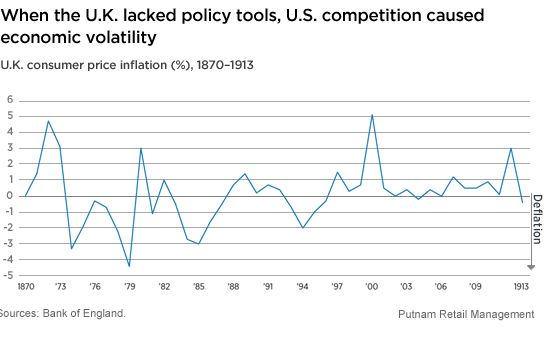The unusual combination of challenges currently facing financial markets prompts investors to search for historic parallels. We find that today’s monetary and fiscal landscape looks a lot like that of Europe and the United Kingdom in the late 19th century. At that time, Europe had no effective monetary or fiscal policy with which it might stabilize the economic shocks caused by competition from the United States — one of the world’s fastest-growing emerging-market economies. Lacking policy tools to manage the impact of this rising power, Europe proved to be highly vulnerable.
As a result, growth was volatile. In the United Kingdom, the standard deviation of annual growth was 2.54% in the 25 years between 1870 and 1895, and gradually wound down to approximately 2.1% by 1910. (For perspective, U.K. growth volatility was 1.66% between 1985 and 2008.) In the late 1800s, real economic volatility in the United Kingdom made for more frequent recessions, which battered workers and companies, and caused frequent bouts of deflation.

We may well be in the process of repeating this history. Today, the United States joins the United Kingdom and Europe in the role of sovereigns at the end of their policy rope, while emerging markets, particularly China, play the role of the late-nineteenth-century United States.
This matters for the markets — particularly fixed income — because these conditions are contributing to a broad repricing of risk. Indeed, fixed-income markets perceive excess risk, and seek to compensate for it, in effect, with liquidity; that is, the most liquid areas of the market command a large premium from potential buyers while assets that are perceived to have liquidity problems have plummeted in price. This sets up a crucial investment opportunity for investors considering spread sectors such as high-yield bonds, niche areas of the mortgage markets, and local emerging-market debt.
Read more in our white paper.
More in: Fixed income, Macroeconomics



